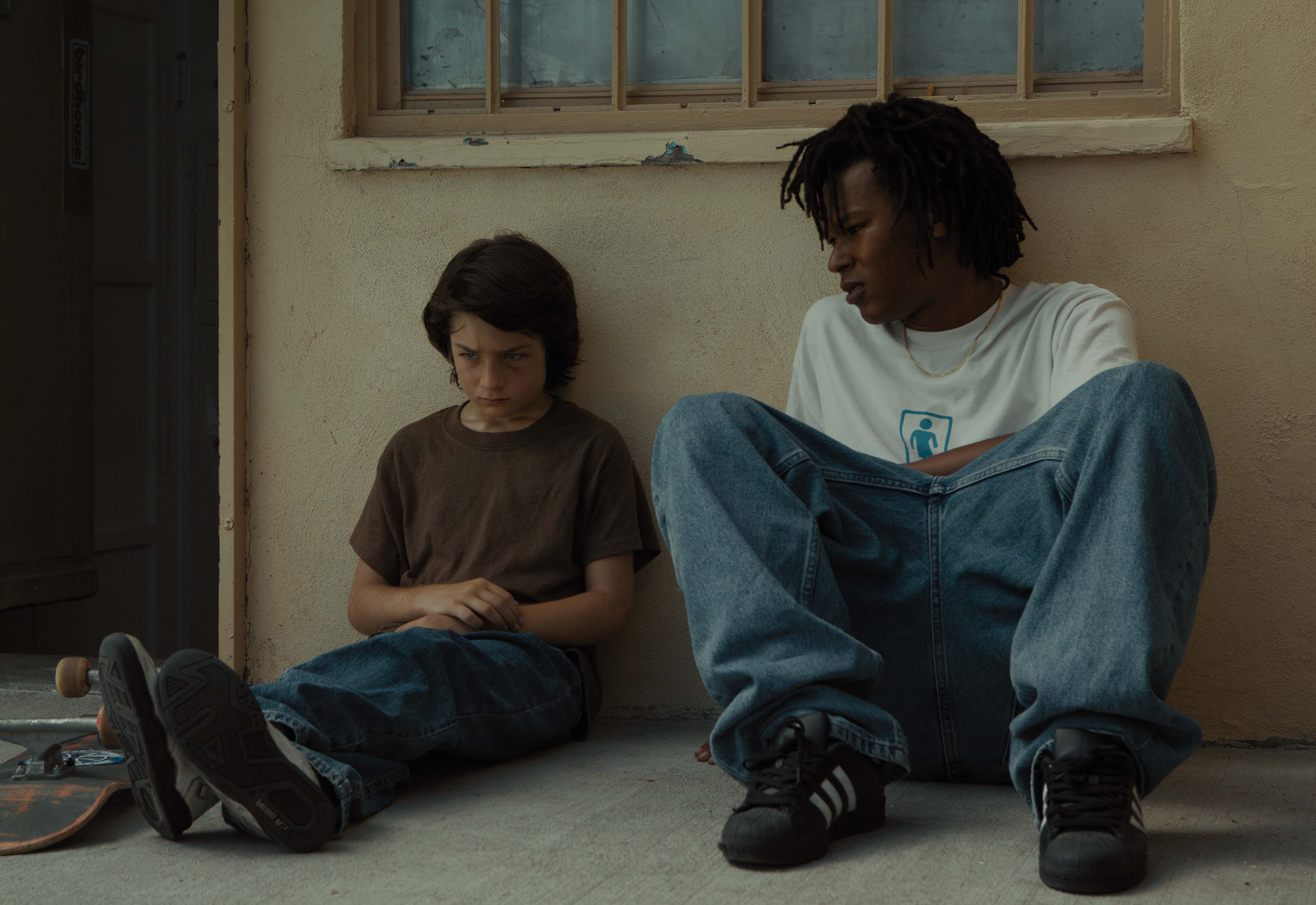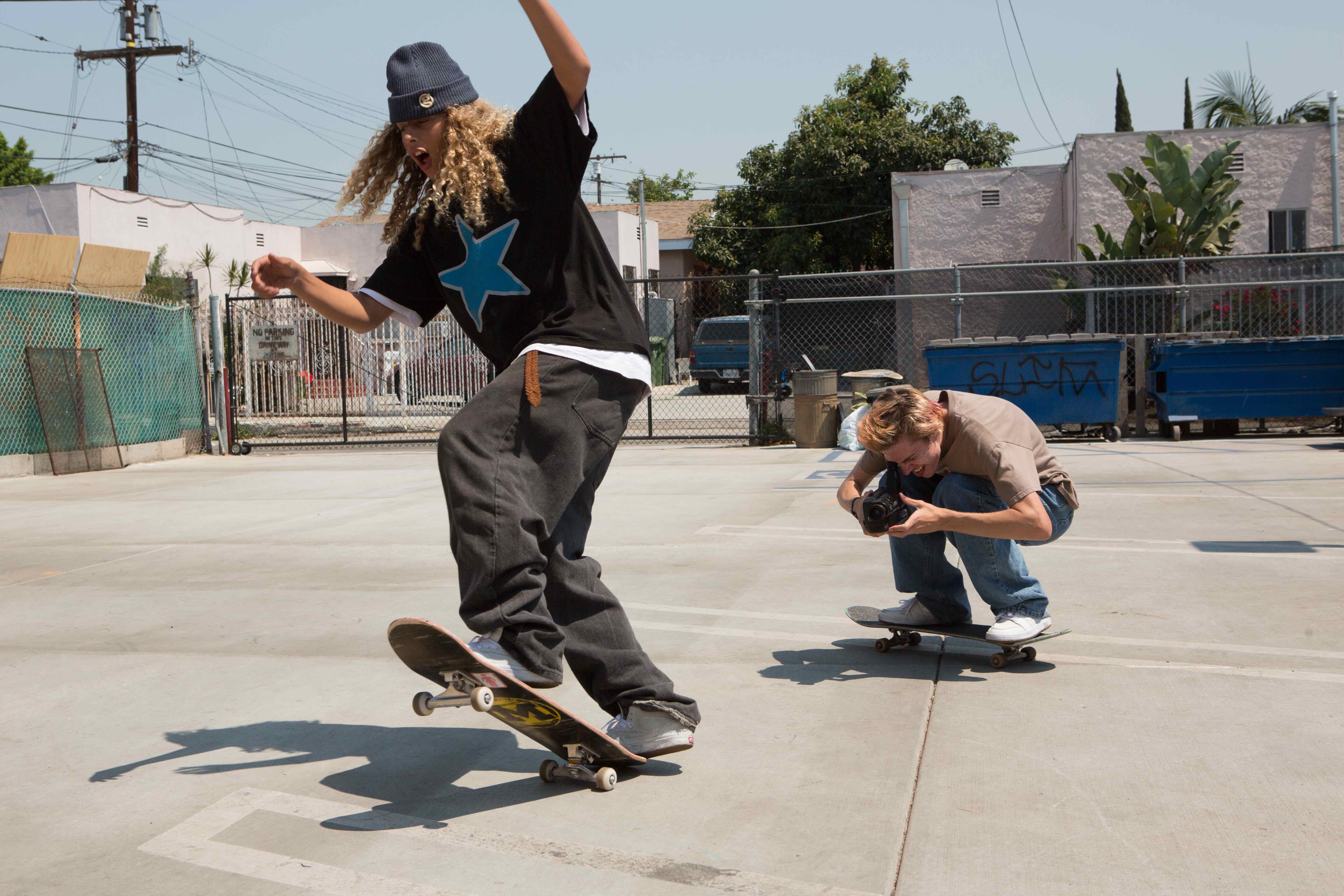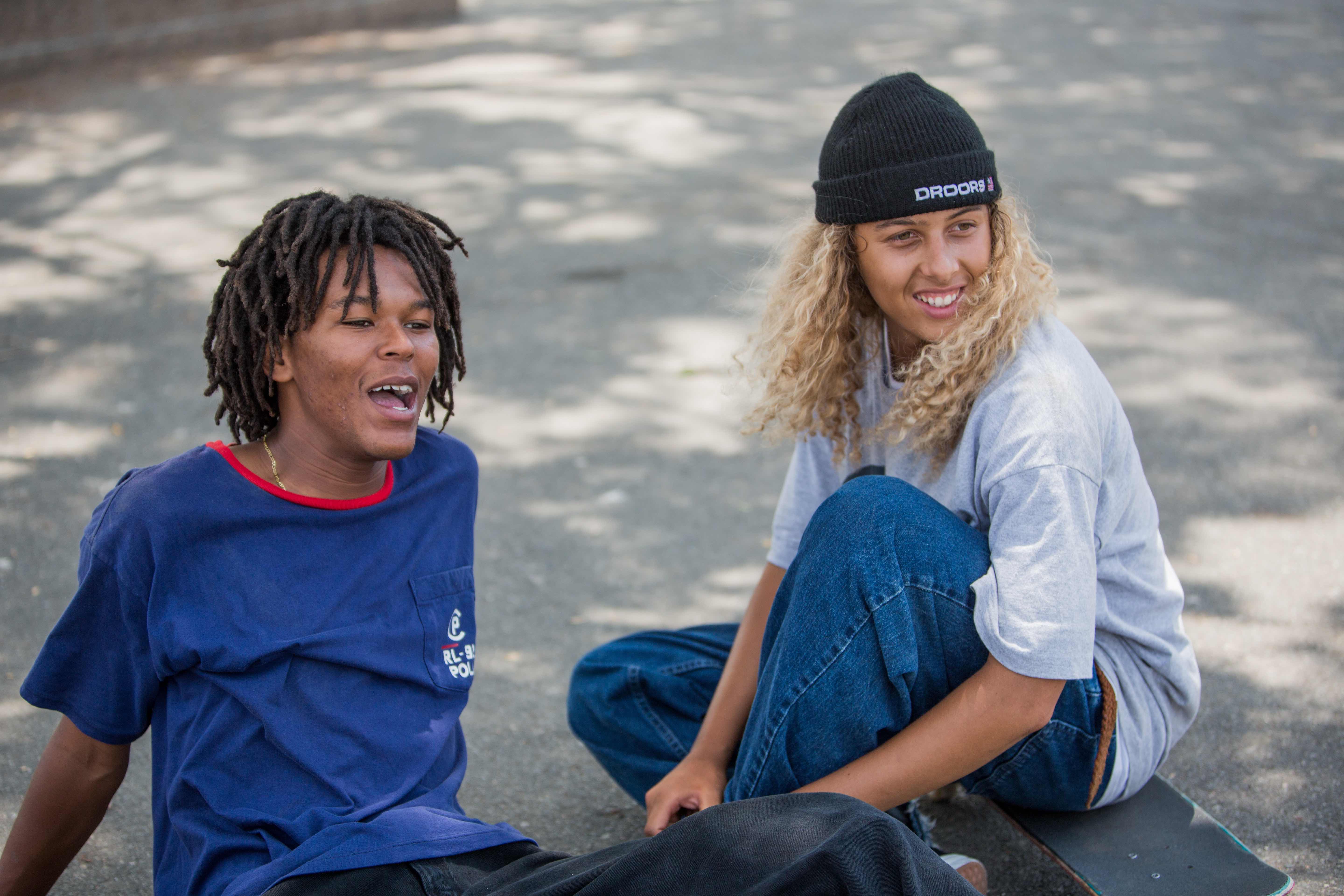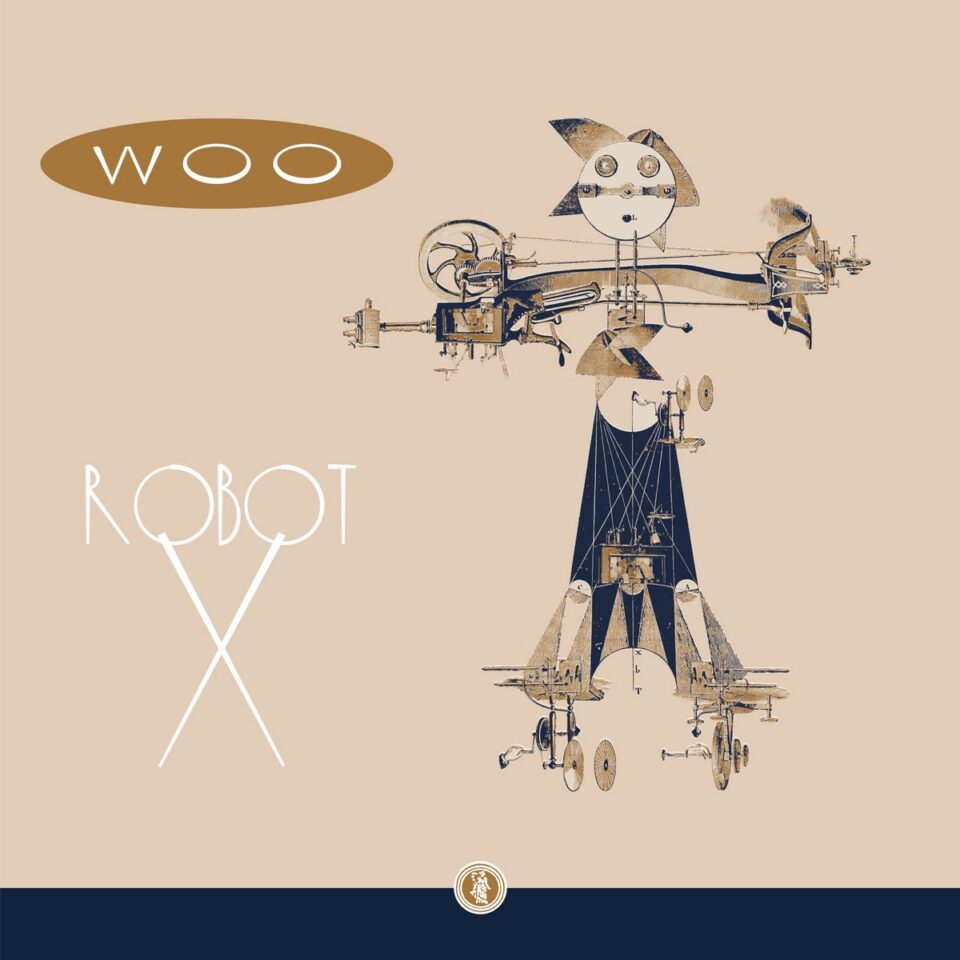“I’m so sorry,” Olan Prenatt says midway through our interview, before turning to his four restless costars. “Yo, let’s get to the questions because, like, she has a limited amount of time. So respect that.”
“The kids,” as their publicist calls them, have been sitting cooped up in a room doing press for so long they’ve all gone a bit crazy. Of the five, only one had substantial professional acting experience prior to starring in Jonah Hill’s mid90s—the youngest, Sunny Suljic, who also starred in Yorgos Lanthimos’ The Killing of a Sacred Deer—which means they are not quite media trained. The rest joined the project after coproducer Mikey Alfred, owner of the skateboard brand Illegal Civilization, suggested them to Jonah, who was casting for a movie about young skateboarders in LA. Rather than teach actors how to skate, Hill found skaters who could act. All the boys are Los Angeles natives except Sunny, who moved here from Atlanta five years ago.
I don’t need Olan’s apology. I like listening to the kids talk over each other, taking the piss out of my questions and blatantly staring at their phones—though his compassion for the journalistic process is appreciated. Na-Kel Smith, the oldest and most experienced skater of the bunch (he’s twenty-four), tips back in his chair for the better part of our hour together, slowly scraping paint off the fancy hotel wall behind him. At one point he surveys me from upside-down, head hanging over the chair’s edge; later, he falls out of it completely. Smith is a vastly talented skater, something you can see a bit in Hill’s film, and even more directly in homemade videos uploaded to YouTube. He slides down handrails and across flights of stairs, flips over fire hydrants, and narrowly avoids traffic. He tries the same trick over and over until he lands it. When he falls, he does so offensively—leaping off the board long before it hits the ground, graceful as a paper airplane. He lands like a cat, limbs taut and controlled, sometimes with a somersault.
“They can’t media train me,” Na-Kel says when I ask how much they were prepped for press. “I think I got a problem with authority. If they tell me I have to do it a specific way, I don’t want to do it.” He very badly wants to get outside and skate, he tells me; he’s had little time do that lately—all thanks to Hill’s pesky film.
“Aveda Curly Curl Controller. You have to let it air dry. I can’t stress that enough.”
— Olan Prenatt
I was nervous about interviewing five young guys at once, thinking I’d get them mixed up. That couldn’t have been less of a problem. Olan Prenatt (the one who apologized) is twenty-two and has the kind of yellow curls and lackadaisical charm teen girls write their first poems about; at one point he gets so excited by something Na-Kel says, he jumps up and knocks a tray of drinks over. His signature move is flipping his hair back after he does a trick (he never ties it up). “People want to know this, Olan,” I begin, but before I can get any further he interrupts: “Aveda Curly Curl Controller. You have to let it air dry. I can’t stress that enough.”
Sunny—the thirteen-going-on-thirty star of mid90s—has shock-bright blue eyes and is small for his age, but intensely confident. He also has a tendency to unconsciously imitate the way Na-Kel and Olan speak every now and then, a kind of street slang (“yee-ah, yee-ah”) that doesn’t fit him. When he does it, the older guys laugh fondly.
The last two are quieter. Ryder McLaughlin is twenty and gentle; he folds into himself while his costars try to pull him out, telling me how good their friend is at music and art and skating because he would never tell me those things about himself. Gio Galicia is fifteen and similarly soft-spoken, the newest skater of the bunch (he’s been doing it four years); he doesn’t often get a word in edgewise because the others overpower him like you would a kid brother. When I’m asking Olan about his hair, Gio and Na-Kel engage in a playful slapping match, the catalyst of which goes unspoken.

from left: Na-Kel Smith, Olan Prenatt, Gio Galicia, Ryder McLaughlin, and Sunny Suljic
Modern skateboarding originated in California. Surfing, which hailed from Hawaii, has been massively popular since ancient Polynesians rode waves, but by the ’50s, surfers stateside needed something to do when those waves were flat. So land-surfing was born.
Last March, an impassioned opinion piece in the Los Angeles Times argued that skateboarding—not surfing—should be Cali’s official state sport. As of 2020 in Tokyo, both sports will make their Olympic debuts, and eight years after that the games are coming to LA, where the newcomers will be right at home.
Skateboarding lends a poetry to LA’s sunburnt beauty: instead of waves, skaters ride the grit and cement of the city itself. Strip-mall parking lots and grimy sidewalks become exalted paradises. There’s usually no use of a court or field—it’s an urban exploit, one needing only endless staircases, curbs, and the golden glow of a fading sunset to light the way.
As reported by the same L.A. Times piece, nearly one out of every ten children between the ages of six and seventeen in LA County knows how to skate (says a survey by the LA84 Foundation)—and 70 percent of those children are nonwhite. This is an affordable sport, the great equalizer: The average household income for surfers tends to be much higher than skateboarders (though pro skaters can earn a lot), according to data from the International Association of Skateboard Companies. Surf gear can set a newbie back $1,000, while a basic skate setup can be found for $100. All you really need is a board and nice weather.
“In the humanity food chain, skaters are pretty low. People think it’s a toy, people don’t think you can make a living for yourself, people assume that you’re anti–The System and need to be controlled and come from a bad home.”
— Na-Kel Smith
Skateboarding isn’t technically a team endeavor—you’re rolling solo—but skaters frequently skate together. You can hear one coming from a couple blocks away, and the noise changes based on what the wheels run over; the metallic slice of a railing, the clatter of pavement, the lump of a sidewalk crack.
Some people hate that noise. Both in mid90s and in videos online, security guards, store owners, and residents are seen trotting out to yell at the kids for skating in public spaces and disrupting the peace. Na-Kel thinks it’s unfair that people playing basketball aren’t chastised in this way, as authority figures assume skaters are hoodlums who’ll vandalize property. “They don’t understand skateboarding is how I feed my family,” Na-Kel says. “People do construction, that shit is loud as fuck. And no one cares. They’re doing that at six o’clock in the morning. Just because we’re doing something that might scratch a little paint off a ledge…”
Olan, true to his nature, has a sunnier take on things. “I think a lot of the time, it’s someone being so envious of these kids having so much fun,” he tells me. Na-Kel doesn’t always have the luxury of picking up his board and leaving a location when he’s scolded by some manner of outsider—he has deadlines to meet, clips or photos he needs to turn in or put online. But when he’s interrupted, it shakes him up. He feels disrespected.
“In the humanity food chain, skaters are pretty low,” he explains. “People think it’s a toy, people don’t think you can make a living for yourself, people assume that you’re anti–The System and need to be controlled and come from a bad home. All this random stuff! People are so used to living by these rules. Everybody thinks they’re so right. But they’re not right at all. They’re doing wrong shit—which is judging people.”
Olan really loves that. “Nak” just spoke some powerful words, he tells me, “some good quotes.” Once again, Olan’s journalistic impulses are sharp.
 While mid90s is a coming-of-age story set in the ’90s, Hill didn’t want it to read as “nostalgia-porn,” so the ’90s details are exact, but slight. It’s not skate-porn, either: we don’t even see a whole lot of skating being done. Hill sought to capture the moments among skaters between the actual skating. Hanging out and shooting the shit, the group dynamics, the competition, the difficult home lives they’re escaping. The film feels a little improvised, though there was a full script written before anyone was cast—and Sunny maintains that if any of them felt a line wasn’t right, Jonah allowed them to make it their own.
While mid90s is a coming-of-age story set in the ’90s, Hill didn’t want it to read as “nostalgia-porn,” so the ’90s details are exact, but slight. It’s not skate-porn, either: we don’t even see a whole lot of skating being done. Hill sought to capture the moments among skaters between the actual skating. Hanging out and shooting the shit, the group dynamics, the competition, the difficult home lives they’re escaping. The film feels a little improvised, though there was a full script written before anyone was cast—and Sunny maintains that if any of them felt a line wasn’t right, Jonah allowed them to make it their own.
Sunny started skating when he was three, and shot mid90s at age eleven. His character is a novice to the sport, so he had to fall and wobble and struggle. “Of course not,” he scoffs, when I ask if he had a stunt double on set. (He falls a lot.) Then again, they all fall more than they land tricks, according to Na-Kel. That’s what skating is.
“In the ’90s it started off as a hyper-masculine thing—there were homophobic slurs and stuff like that. Now we have [Brian Anderson], who is a pro who just came out [as gay], which is sick, and it’s just a more open community.”
— Ryder McLaughlin
As for safety, none of them wear helmets on screen—or off it. “It weighs your head down weird and makes your neck hurt,” says Na-Kel. “And they look dumb as hell.” I ask how much that matters if it were to keep his head from splitting open. “I’m down with the pain,” he replies impishly. Olan looks disturbed. “Let’s stop talking about this,” he says.
There aren’t any female skaters in mid90s, and I didn’t see any when I stopped by the popular Stoner Skate Plaza in West LA either, yet the boys claim there are more girl skaters now than ever before, while admitting it has historically been a boys’ club. “In the ’90s it started off as a hyper-masculine thing—there were homophobic slurs and stuff like that,” says Ryder. “Now we have [Brian Anderson], who is a pro who just came out [as gay], which is sick, and it’s just a more open community.” On the subject of hateful speech, Jonah has been criticized for including a gay slur in much of his film’s dialogue, and has defended the word as part of period authenticity. “I think people who grew up in that time period are having to unlearn a lot of messed-up lessons that were learned back then,” he told Slate. “We’re talking about language that is ugly, behavior that is ugly. I felt it was more important to tell the truth and have that be the lesson, and show it in its ugliness, than to go back and change history.”
 As dissected by The Ringer’s Eric Ducker in a consummate “History of Skateboarding Movies,” the sport and its cinematic companions have changed. Where films once followed skaters fighting the power and proving they could defy societal strictures, they are now likelier to depict skating as “an internal struggle, a meditation.” Skateboarding is not simply something disenfranchised youths do to blow off steam anymore—thanks to “cultural polyglots” like Pharrell Williams and Tyler, The Creator, skating has become a jumping-off point for people who want to design shoes, “make beats” (the boys refer to music this way), and get money.
As dissected by The Ringer’s Eric Ducker in a consummate “History of Skateboarding Movies,” the sport and its cinematic companions have changed. Where films once followed skaters fighting the power and proving they could defy societal strictures, they are now likelier to depict skating as “an internal struggle, a meditation.” Skateboarding is not simply something disenfranchised youths do to blow off steam anymore—thanks to “cultural polyglots” like Pharrell Williams and Tyler, The Creator, skating has become a jumping-off point for people who want to design shoes, “make beats” (the boys refer to music this way), and get money.
With iPhones and affordable cameras available to just about anyone, kids today can make their own damn skateboarding movies, even if it’s just for themselves. That’s how Jonah knew he could find skaters who were both legitimate and comfortable in front of the camera: “Look at any kid’s Instagram,” he told The New Yorker. “All skaters do is film each other.” Despite this, it was Jonah’s time spent in front of the camera—as an actor—that has clearly influenced his sleek ability to step behind it: His film is one in which the actors don’t feel like actors because they’re given space to be themselves. There is a rare flicker of real life.
“I’ll be on tour for acting and doing a bunch of press for three weeks, and I don’t [get to] skate. Then at the same time, I almost want to make up for that time, and I’m more eager to skate. I appreciate it more.”
— Sunny Suljic
The movie’s subjects agree they’ll be pursuing more acting roles going forward, though skating remains their first love. “I’ll be on tour for acting and doing a bunch of press for three weeks, and I don’t [get to] skate,” says Sunny somewhat dejectedly, before ending on a wiser note: “Then at the same time, I almost want to make up for that time, and I’m more eager to skate. I appreciate it more.” Everyone has side projects: Na-Kel has clothes coming out with Adidas—and all of them are interested in making beats.
“We do everything,” Na-Kel says. “It’s 2018, ain’t no more boxes. We broke them shits down.”
“Ah! We BROKE ’EM DOWN…” Olan cries out. “WOO! We cut the tape.”
“You know all the little foam, the packaging stuff…” Na-Kel mimes digging through styrofoam pieces. “I kicked the box. Like, boom! I kicked it far.” He leaps to his feet and shows me a kick. FL









